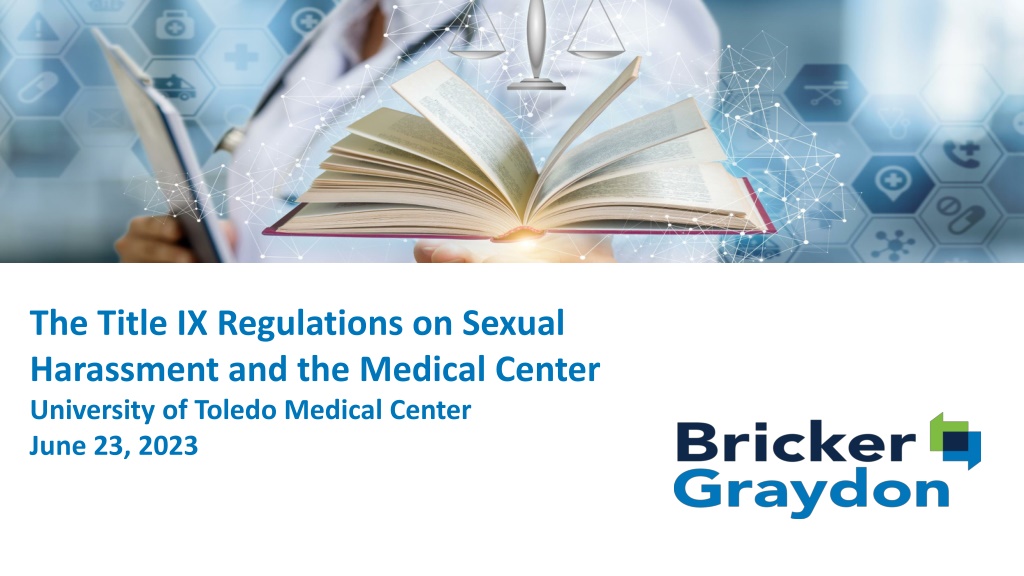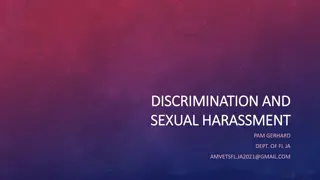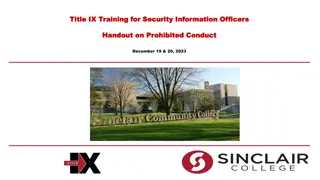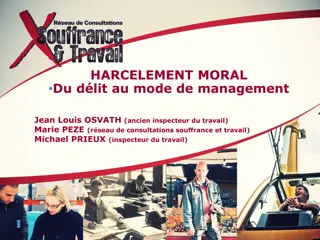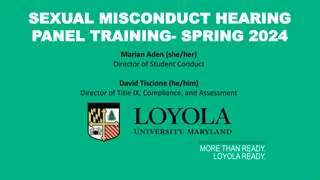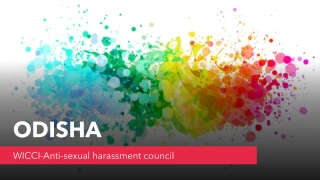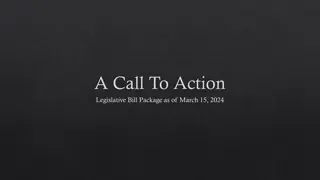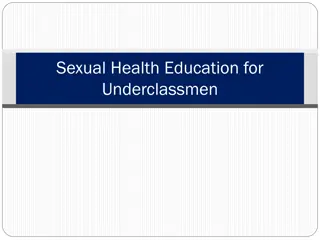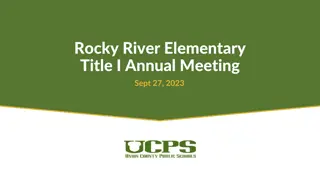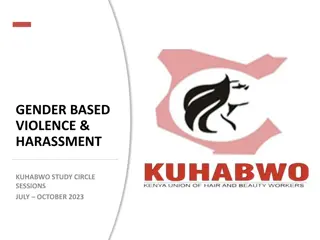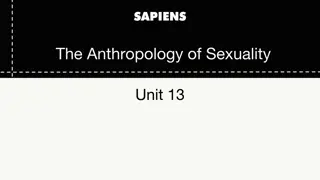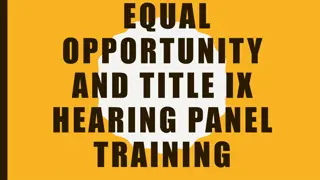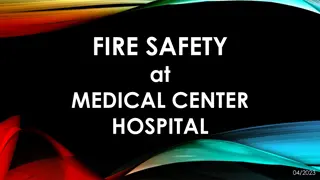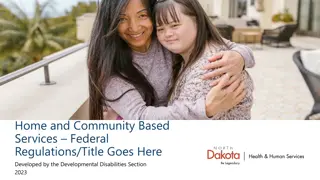The Title IX Regulations on Sexual Harassment and the Medical Center
Presentation on Title IX regulations and training requirements for addressing sexual harassment at the Medical Center University of Toledo. The session covers the importance of Title IX, practical implications, mandatory reporting policies, and training obligations under US regulations.
Download Presentation
Please find below an Image/Link to download the presentation.
The content on the website is provided AS IS for your information and personal use only. It may not be sold, licensed, or shared on other websites without obtaining consent from the author. Download presentation by click this link. If you encounter any issues during the download, it is possible that the publisher has removed the file from their server.
Presentation Transcript
The Title IX Regulations on Sexual Harassment and the Medical Center University of Toledo Medical Center June 23, 2023
Presenter Information Erin Butcher Attorney ebutcher@brickergraydon.com Bricker Graydon LLP
Disclaimer This presentation does not constitute legal advice. Consult with competent legal counsel regarding how best to address your specific situation. 3 3
Agenda 9:00-9:10 Why you are here in this training 9:10-10:30- Title IX and why it applies to the Medical Center and the Title IX Regulations 10:30-11:00 - Practical implications for Title IX at the Medical Center 4 4 4
Training Requirements Under US Regulation An institution must provide training for its investigators, decision- makers, Title IX Coordinator(s), and appeals officers Definition of sexual harassment Scope of your education program/activity How to conduct an investigation and grievance process including hearings, appeals, and informal resolution processes (as applicable) How to serve impartially, including by avoiding prejudgment of the facts at issue, conflicts of interest, and bias Issues of relevance (investigators and probably decision-makers) 6 6
Mandatory Reporting under the Policy Mandated Reporter: A University employee who is obligated by this policy to share knowledge, notice, and/or reports/allegations of sex discrimination, sexual harassment and/or retaliation with the Title IX Coordinator. 3364-50-01(E) Title IX Policy All employees of the University (including student employees), with the exception of those who are designated as Confidential Resources (licensed counselors, health providers in a confidential role, Victims Advocate), are Mandated Reporters and must promptly share with the Title IX Coordinator all known details of a report made to them in the course of their employment. 3364-50(Q)(2) Title IX Policy 7 7
And.. Training on sexual harassment to reduce (with the goal of eliminating) sexual harassment. 8 8
Title IX and How Title IX Applies to the Medical Center
Title IX What is Title IX? What is Title IX? Title IX provides: Title IX provides: no person in the United States shall, on the basis of sex, be excluded from participating in, be denied the benefits of, or be subjected to discrimination under any educational program or activity receiving federal financial any educational program or activity receiving federal financial assistance assistance. 20 U.S.C. 1681(a) (emphasis added). 10 10
Federal cases clarify Title IX and medical centers Doe v. Mercy Catholic Medical Center, 850 F.3d 545 (3d Cir. 2017). Facts: Doe, a former radiology resident, alleged that the director of her program repeatedly sexually harassed her and retaliated against her for complaining about his behavior. Doe alleged that she was terminated from her program in retaliation for bringing a complaint against her supervisor. She brought claims under Title VII and Title IX seeking damages against Mercy Catholic Medical Center ( Mercy ). Procedure and Appeal to Third Circuit: Her Title IX claim was dismissed by the district court who determined that Mercy s program was not covered by Title IX s scope as Mercy was not an educational institution. The Third Circuit reversed. In finding that Title IX could apply to Mercy, the court first analyzed whether Mercy s residency program could constitute an educational program or activity under Title IX. 11 11
Four-Factor Test Third Circuit, applying the CRRA, extended the reach of Title IX to Mercy s medical residency program. Four Feature Test Is this an educational program? (A) program is incrementally structured through a particular course of study or training, whether full- or part-time; (B) program allows participants to earn a degree or diploma, qualify for a certification or certification examination, or pursue a specific occupation or trade beyond mere on-the-job training; (C) program provides instructors, examinations, and evaluation process or grades, or accepts tuition; or (D) the entities offering, accrediting, or otherwise regulating a program hold it out as educational in nature 12 12
2020 Regulations also clarify coverage The Title IX Regulations define a program or activity as all of the operations of: A college, university, or other postsecondary institution, or a public system of higher education; or An entire corporation, partnership, other private organization, or an entire sole proprietorship (A) If assistance is extended to such corporation, partnership, private organization, or sole proprietorship as a whole; or (B) Which is principally engaged in the business of providing education, health care, housing, social services, or parks and recreation; or [* * *] [The Title IX Regulations] appl[y] to every recipient and to the education program or activity operated by such recipient which receives Federal financial assistance. 34 C.F.R. 106.11 13 13
Why Would Title IX Apply? Does your hospital provide clinical experience for students and/or residents? Does your hospital provide medical/healthcare/wellness services to schools, colleges/universities or other educational programs? Does your hospital participate in research activities that are federally funded? Does your hospital receive federal grants or other federal sources of funds? 14 14
Other Corporate Considerations If you have a multi-campus system with a parent- subsidiary relationship between the campuses (each as individual corporations) does the Title IX requirements attach to only the corporation (subsidiary campus) that receives federal assistance or aid? Do you have medical affiliation agreements (shared staff, faculty appointments)? Clinical programs with local colleges and universities? 15 15
Title IX Regulations and UTs TIX Policy What do they require?
Some Terminology Complainant An individual who is alleged to be the victim of sex discrimination, sexual harassment, and/or retaliation. Respondent An individual who has been reported to have engaged in conduct that could constitute sex discrimination, sexual harassment, and/or retaliation under the policy. Formal Complaint A document submitted or signed by the Complainant or signed by the Title IX Coordinator alleging a Title IX policy violation by a Respondent and requesting that the University investigate the allegation(s). Mandatory Reporter All University employees. 3364-50-01 The University of Toledo Title IX Policy (E) 17 17
The Basic Concepts The University of Toledo ( UT ) must assess all reports that come in and, if there is a formal complaint (defined on the previous slide), UT must investigate and proceed through the formal complaint process (next slide). The Medical Center/UT cannot discipline a Respondent for conduct alleged to have violated the University of Toledo Title IX Policy (the TIX Policy ) until and unless the Respondent has been determined, after a live cross-examination hearing, to have violated the Policy by a preponderance of evidence. Respondents also must have the presumption of no violation unless found in violation by this process and standard. 18 18
Sexual Harassment Definition Conduct on the basis of sex or that is sexual that satisfies one or more of the following: (1) Quid Pro Quo (2) Sexually Hostile Environment (3) Sexual Assault (4) Dating Violence (5) Domestic Violence (6) Stalking 19 19
Sexual Harassment Quid Pro Quo (1) Quid Pro Quo (a) A University employee, (b) Conditions the provision of a University aid, benefit, or service, (c) On an individual s unwelcome sexual conduct. 20 20
Sexual Harassment Hostile Environment (2) Sexual Harassment (a) Unwelcome conduct, (b) Determined by a reasonable person, (i) To be severe, and (ii) Pervasive, and (iii) Objectively Offensive, (c) That it effectively denies a person equal access to the University s education program or activity. 21 21
Sexual Harassment Sexual Assault - Forcible (3) Sexual Assault (a) Forcible (i) Any sexual act directed against another person, (ii) Without the consent of the Complainant, (iii) Including instances in which the Complainant is incapable of giving consent. 22 22
Consent Knowing, and Voluntary, and With clear permission, By word or action To engage in sexual activity. 23 23
Sexual Harassment Sexual Assault Non- Forcible (3) Sexual Assault (b) Non-Forcible (i) Incest (ii) Statutory rape 24 24
Sexual Harassment Dating Violence (4) Dating Violence (a) Violence, (b) On the basis of sex, (c) Committed by a person, (d) Who is or who has been in a social relationship of a romantic or intimate nature with the Complainant. 25 25
Sexual Harassment Domestic Violence (5) Domestic Violence (a) Violence, (b) On the basis of sex, and (c) Committed by a current or former spouse or intimate partner of the Complainant, or (d) By a person with whom Complainant shares a child in common, or (e) By person who is cohabitating with, or has cohabitated with, the Complainant as a spouse or intimate partner (not just a roommate), or (f) By a person similarly situated to a spouse of the Complainant under domestic or family law of Ohio, or (g) By any other person against an adult or youth Complainant who is protected from that person s acts under domestic or family law in Ohio. 26 26
Sexual Harassment Stalking (6) Stalking (a) Engaging in a course of conduct, (b) On the basis of sex, (c) Directed at a specific person, that would cause a reasonable person to (i) Fear for the person s safety, (ii) Fear for the safety of others, or (iii) Suffer substantial emotional distress. 27 27
Overview of the Process Report Formal Grievance Process : Informal Resolution Investigation Hearing Supportive Measures Formal Complaint Written Decision Appeal Dismissal 28 28
Receiving Reports You have actual knowledge of sexual harassment when someone reports allegations of sexual harassment to the Title IX Coordinator or to any official of the recipient who has the authority to institute corrective measures on behalf of the recipient Actual knowledge triggers a duty to: Contact the complainant to offer supportive measures and discuss their options to resolve the concerns Potentially, initiate an investigation even if the complainant does not wish to do so (risk analysis) 29 29
Supportive Measures Non-disciplinary, non-punitive individualized services as appropriate, as reasonably available, and without fee or charge to the individual receiving the services Designed to restore or preserve equal access to your program until the case is resolved Examples: Counseling, deadline extensions, modifications of work/class schedules, campus escort services, no-contact restrictions, changes in work locations, leaves of absence, increased security Note: Both parties are eligible for supportive measures. 30 30
Threshold Issue Not all reports will trigger a process! To go forward, must meet all of the following requirements: Complainant must be participating in or attempting to participate in the recipient s education program or activity of the recipient when the formal complaint is filed Reported behavior must be directed at a person physically present in the United States Reported behavior must potentially qualify as sexual harassment if it is proved Reported behavior must have occurred in the recipient s education program or activity If formal complaint does not meet these requirements, must dismiss (but can still address conduct through another policy) 31 31
Formal Resolution - Investigation Upon receipt of formal complaint of sexual harassment, provide detailed notice of allegations to both parties. See 34 C.F.R. 106.44(b)(2). Must be done before you interview the respondent! Investigator interviews parties and relevant witnesses. Each party may bring an advisor of their choice, who may be an attorney or a union representative. Investigator gathers interview summaries and relevant evidence into a case file. 32 32
Evidence Sharing Parties and advisors receive 10 days to review relevant evidence directly related to the complaint (which may include a draft investigative report) and provide a written response Investigator prepares a written investigative report that fairly summarizes all relevant evidence, including inculpatory and exculpatory evidence Parties and advisors have another 10 days to review investigative report and provide a written response 33 33
Evidence Sharing Parties and advisors receive 10 days to review relevant evidence directly related to the complaint (which may include a draft investigative report) and provide a written response Investigator prepares a written investigative report that fairly summarizes all relevant evidence, including inculpatory and exculpatory evidence Parties and advisors have another 10 days to review investigative report and provide a written response 34 34
Hearing Live, cross-examination hearing Parties must have advisors of their choice (University will appoint if the parties do not have their own) because all questioning must be conducted through advisors Hearing decision-maker or panel will conduct the hearing University will maintain a recording of the hearing 35 35
Parties Involved Employees and Contractors Employees: Hospitals/employers must ensure risks are minimized for employees Health care providers = Ohio law and reporting rules apply Contractors and vendors: CMS CoP 482.12(e): Contracted Services What are the contractual terms who s policies govern? Do they include prohibition against discrimination and harassment? Do they include Title IX Coordinator (or designated official for complaints)? 37 37
Parties Involved Patients and Patients Rights Considerations (1 of 3) Patients: CMS CoP 482.13: Patient s Rights 482.13(a)(2): Hospital Grievance Process Grievance : formal or informal written or verbal complaint to hospital by patient (or patient representative) regarding patient s care and includes allegations of abuse, neglect or other unethical behavior. Grievance process must: Clearly explain procedure to submit grievance Promptly review, investigate and resolve grievance Provide written notice of decision to patient (or patient representative) that includes: Name of hospital contact person Steps taken on behalf of patient to investigate Results of the grievance process Date of completion 38 38
Parties Involved Patients and Patients Rights Considerations (2 of 3) Patients: CMS CoP 482.13: Patient s Rights 482.13(c)(2): Care provided in a safe setting Hospitals must protect patients Conduct patient risk assessments Identify vulnerable patient populations Provide adequate staffing levels for appropriate patient observation/monitoring Assess safety risks in all patient care area Provide appropriate security and systems to protect patients Limit/restrict unwanted visitors 39 39
Parties Involved Patients and Patients Rights Considerations (3 of 3) Patients: CMS CoP 482.13: Patient s Rights 482.13(c)(3): Patient right to be free from all forms of abuse/harassment Hospital must ensure patients are free from all forms of abuse, neglect or harassment from staff, other patients and/or visitors. Be proactive to prevent or identify events/occurrences that may constitute abuse. Policies for investigation of abuse allegations must include: Methods to protect patients from abuse during investigation of allegations. Investigations of abuse or mistreatment are timely, objective and thorough. Appropriate corrective action occurs and incidents of abuse or harassment are reported in accordance with applicable federal, state and local laws. 40 40
Case Study #1 Resident v. Physician Resident Fedup tells her program coordinator that she no longer wants to be scheduled for surgical cases with Dr. Hawkeye because he makes inappropriate sexual jokes and suggestive comments during every surgery. The program coordinator responds that he is harmless and a talented surgeon that they are lucky to have on staff. The Program Coordinator also says that no other residents have complained (she is the only female surgical resident) besides she has to work with Dr. Hawkeye in order to get the right case mix to complete her training. The next day Resident Fedup is seen rushing out of the OR very flustered. A scrub tech tells the OR manager that when they were scrubbing out and talking about her upcoming wedding, Dr. Hawkeye interrupted Don t get pregnant until you have completed with your residency. 42 42
Case Study #2 Nursing student vs. Resident RN student Lauren told her preceptor that she feels like Resident Creep follows her around the hospital and always shows up on whatever unit she is assigned. Lauren is leaving a patient s room in the ICU. When she starts to remove her PPE, Resident Creep walks over closely to her and whispers Take it all off so I can take some pictures for later tonight. 43 43
Case Study #3 Patient vs. Nurse Patient Daisy wakes up and complains to Nurse Stephanie that she was assaulted by a man during the night. Nurse Stephanie asks what happened. Daisy says she doesn t know the man but he rubbed her pelvic area during the night. Then Nurse David walks in the room to check on Daisy and Daisy becomes frightened and tells Nurse Stephanie, It was him! and points to Nurse David. Nurse Stephanie calls Security and speaks with David who says he changed Daisy s catheter during the night. 44 44
Final Thoughts The law sets the floor, not the ceiling. How your treat your students and employees figures not just into legal compliance, but also: Retention Recruiting Public Relations Donations What is both compliant and consistent with your institution s ethic of care? 45 45
Keep in Touch! Find us on LinkedIn: Erin Butcher Subscribe to our newsletter on our homepage by clicking subscribe in the upper right corner 46 46
